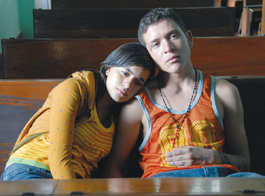home | metro silicon valley index | movies | current reviews | film review

Photograph by Eniac Martinez
TRAIN THEY RIDE: Paulina Gaitan and Edgar Flores try to make it across the border.
Coming to America
Cary Fukunaga's powerful drama 'Sin Nombre' charts a dangerous journey across the border
By Richard von Busack
WE WHO write about film in the Bay Area like to think we keep a good eye on upcoming talents. And then a phenomenon like Cary Fukunaga comes along, and we're caught with our pants down. Fukunaga lived around the bay, growing up in the hills of east Oakland before moving to Sonoma County and then Albany.
Over the phone, Fukunaga told me that he was a UC–Santa Cruz grad: College Eight, American History. He wrote his thesis on the politics of history-telling, which he illuminated with the story of two controversial exhibits at the Smithsonian. "It was great," Fukunaga says of his five years at UC, but he adds that he didn't become a film major there, because he thought the film professors were "pretentious."
Fukunaga moved on to NYU film school. With the help of the Sundance Institute, he created a feature film as his thesis. His much-lauded debut, Sin Nombre, invites comparisons to Nicholas Ray's They Live by Night and Terrence Malick's Badlands. Yet Sin Nombre ("Without Name") isn't consciously modeled on any of these films.
I asked if he had been thinking of great film noirs in the movie's closing scenes: Casper (Edgar Flores), a young lieutenant of the Mara Salvatrucha gang, hides in a shipment of cars to the U.S. border with his Honduran friend Sayra (Paulina Gaitan). She has been crossing Mexico by land in order to join her family in New Jersey. It is the exact moment where they've gone from fellow travelers to people in love. Casper knows he's a goner; the graffiti he sees lets him know that his gang has pronounced him dead—the writing is literally on the wall.
Fukunaga does not mention crime-story movies when recalling this particular scene; what he was after, he says, was the magic-hour twilight shots of Iceland in Bradley Rust Gray's 2003 Salt. "The theme of men on the run could be found in Westerns as well as film noir," he offers.
It seems that Fukunaga, then, is an intuitive filmmaker, not all that comfortable spelling out the deeper themes or motives. In Sin Nombre, it is what's upfront that counts.
What interested me then is the film's success in showing ranges of experience. For a young first-time feature filmmaker, Fukunaga has succeeded at reconciling the tragedy and beauty of this life on the run. The movie contains multitudes: pearlescent dawn shots of smoking volcanoes, barrios seen from the crowded top of a freight train—one rider loops his belt on a railing so he won't fall off when he sleeps.
We're in the company of immigrants who carry cell phones and are still reduced to drinking ditchwater. There are lyrical interludes of refuge at stops along the rail yards where the travelers bathe and are fed. On the railroad trackside, there are locals with offerings of fruit—sometimes they carry rocks to throw.
This passionately told and moody film includes the horrific side of urban Mexican life: of gangsters with homemade iron shotguns, whose faces are blue with demonic tattoos. One way they make money is by shaking down the Central American immigrants who come through their domain.
In their lost-boys clubhouse, they butcher their rivals and feed them to their pit bulls. The film's near-last shot of a particularly grueling tattooing may seem to be too much to be true. In fact, it's public record that the Marielistas of Cuba used to go in for just this kind of marking.
But the film's great moment of alienation actually takes place in the United States: it's a shot, high up and wheeling, of a vast and vacant shopping-center parking lot at dawn, as inhospitable as the surface of Mars. It's rare we've seen the contrast of two separate worlds—the different sides of the border—made so clear and sharp.
Explaining how he came up with the film's title, Fukunaga says, "During my research, when I was at the Mexican side of the Rio Grande, I saw these crosses without names, dedicated to those who didn't make it. I thought this was a very touching detail, about those who died trying to reach the American dream. The title refers to them—not only to the members of the gang who lose their real names when they go in."
Sin Nombre is the kind of movie that's usually het up in the visuals. In fact, Fukunaga's lens is tranquil and objective. Could Sin Nombre be the first post-hip-hop urban movie? "You mean, post-MTV editing? I don't know—pre- or post-MTV," Fukunaga says. "City of God is a great film, but the look of City of God has become invariable [in movies about gangs]: high-contrast, supersaturated and an obvious choice to avoid."
For further reading, Fukunaga recommends Enrique's Journey by the Los Angeles Times' Sonia Nazario (soon to be a Lifetime channel movie) and Carlos Fuentes' The Crystal Frontier. It's interesting that this week there are two excellent movies about the immigrants' tale, Sin Nombre and Sugar. Both films counter the sometimes hysterical rhetoric of nativist politicians with the stories of decent people caught between a hard place and a border.
![]() SIN NOMBRE (R), directed and written by Cary Fukunaga, photographed by Adriano Goldman and starring Edgar Flores and Paulina Gaitan, opens April 10.
SIN NOMBRE (R), directed and written by Cary Fukunaga, photographed by Adriano Goldman and starring Edgar Flores and Paulina Gaitan, opens April 10.
Click Here to Talk About Movies at Metro's New Blog
Send a letter to the editor about this story.
|
|
|
|
|
|